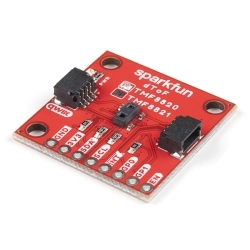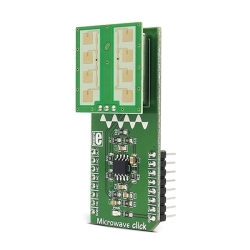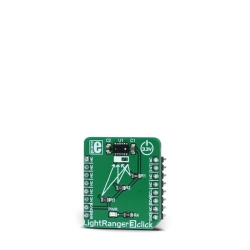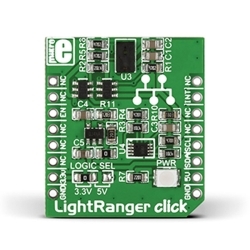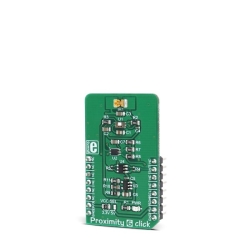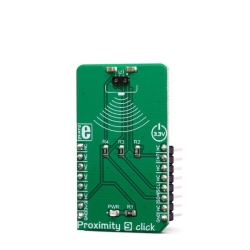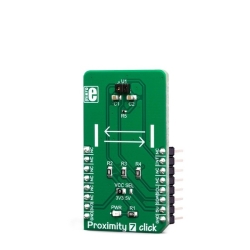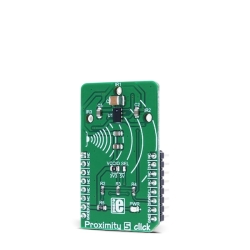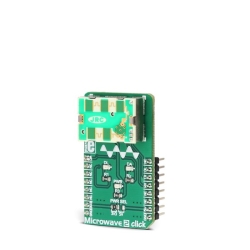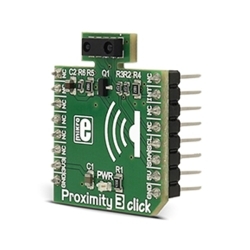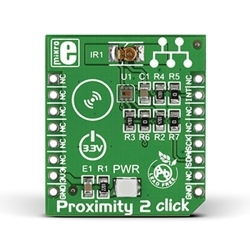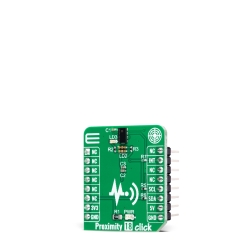MIKROE Proximity 12 Click
MIKROE Proximity 12 Click is a compact add-on board that contains a high-performance light and proximity sensing solution.
Product Overview
MIKROE Proximity 12 Click is a compact add-on board that contains a high-performance light and proximity sensing solution. This board features the TMD3719, an optical sensor that integrates ambient light sensing, proximity detection, and flicker detection sensing from AMS-AG. This I2C configurable sensor has six concurrent ambient light sensing channels and a proximity function that synchronizes IR emission and detection to sense nearby objects. On-chip flicker detection processing removes the processing overhead from the central application processor, reducing latency in the flicker-detection results, enabling comprehensive detection of ambient light flicker frequency to remove unwanted artifacts. This Click board™ is suitable for consumer and industrial applications such as brightness and color management, flicker-immune operations, and many more.
Proximity 12 Click is supported by a mikroSDK compliant library, which includes functions that simplify software development.
Proximity 12 Click as its foundation uses the TMD3719, an optical sensor that integrates ambient light sensing, proximity detection, and flicker detection sensing from AMS-AG. The ambient light and color sensing function provide six concurrent ambient light sensing channels: Red, Green, Blue, Clear, Leakage, and Wideband, which accurately measure ambient light and calculate illuminance, chromaticity, and color temperature. The TMD3719 also integrates direct detection of ambient light flicker for four selectable frequency bins, executed parallel with ambient light and color sensing.
The proximity function synchronizes IR emission and detection to sense nearby objects. This function features self-maximizing dynamic range, ambient light subtraction, and advanced cross-talk cancelation. The proximity engine recognizes detect/release events and produces a configurable interrupt, routed to the INT pin of the mikroBUS™ socket, whenever the proximity result crosses upper or lower threshold settings.
Proximity 12 Click communicates with MCU using the standard I2C 2-Wire interface with a maximum clock frequency of up to 400kHz. In addition to I2C communication, several GPIO pins connected to the mikroBUS™ socket pins are also used. The SYN pin, routed to the CS pin of the mikroBUS™ socket, is used to synchronize data and allows the start of the classic ambient light, proximity sensing, and flicker detection with every new SYN signal instead of immediately. It also has two pins labeled GP1 and GP2, routed on the RST and PWM pins of the mikroBUS™ socket, used as general-purpose pins, more precisely, GP1 as open-drain general purpose input/output and GP2 only as an input pin.
The TMD3719 requires a supply voltage of 1.8V to work correctly. Therefore, a small regulating LDO is used, the BH18PB1WHFV from Rohm Semiconductor, providing a 1.8V out of 3.3V mikroBUS™ rail. The LDO cut power consumption by lowering its current consumption to approximately 2μA when the application is operating in the Standby state.
This Click board™ can be operated only with a 3.3V logic voltage level. The board must perform appropriate logic voltage level conversion before use with MCUs with different logic levels. However, the Click board™ comes equipped with a library containing functions and an example code that can be used, as a reference, for further development.
Features & Specs
- Interface: I2C
- Compatibility: mikroBUS™
- Dimensions: 28.6 x 25.4mm
- Input Voltage: 3.3V
- Operating Range: 20cm
- Peak Wavelenght: 940nm
- Operating Temperature Range: Min. -30°C, Typ. +25°C, Max. +85°C
Documentation
Customer Reviews
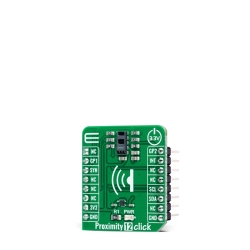
Stock and Customer Discounts
Available Discounts
- $20.85 | 25+ units
- $19.76 | 100+ units





